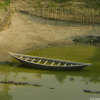
The World Economic Forum (WEF) Global Risk 2014 Report ranks water crises as the third greatest global economic risk, just after fiscal crises in key economies and employment rate challenges; and water related risks of extreme weather events (#6) and food crises (#8) rank in the top ten. However, Lloyd’s Risk Index (LRI) ranks water scarcity at number thirty-three on their list of global risks. WEF characterizes global risks as systemic risks where modest tipping points can combine indirectly to produce large failures, where a loss can trigger a chain reaction, and in which systems won’t recover equilibrium after a shock. The specific nature of the WEFs definition of risks, and high ranking of multiple water related risks, seems to speak directly to the interests of the business leaders involved in Lloyd’s assessment. How can two assessments of global risks come to such different conclusion about the relative importance of water related risks?
LRI’s assessment is aimed at assessing corporate risk and preparedness as perceived by business leaders from across the globe. These senior executives and corporate board members have a number of priorities, and current concerns about supply chain or materials cost may very easily trump concerns about extreme weather events, climate change or water scarcity impacting relevant sectors or economies. Also, more than half of the respondents are from Europe or North America, and most of Africa and Latin America were not well represented. This reported global perspective of risk may be skewed due to limited geographic representation. When LRI breaks down the risks valued by business leaders by region, it becomes clear that part of this difference is water problems are experienced locally and may not rate as much attention across geographic or sectoral boundaries: water scarcity risk ranks as the 17th priority for Latin American leaders, and 41st for European respondents. Water related risks of flooding, drought, food security and climate change also vary in rank across the broad geographic regions defined by Lloyd’s.
The WEF report highlights the connectivity of climate change, extreme weather, water scarcity, and food security and how they can engage in a continuous feedback cycle. Extreme weather and changing precipitation patterns linked to climate change effect regions differently, some experience the challenges of too much water and other too little water through prolonged droughts. Extreme weather events present local and national governments with the task of emergency management for events of unprecedented magnitude, duration or repetition.
Peter Brabeck (of Nestlé) and Asit Biswas (Water Diplomacy RCN Member) presented their analysis of the WEF report earlier this year in the Business Standard, which attempts to shine a light on water risks by viewing the problems from perspectives of people who live with water insecurity. They state that the largest water risk has been ignored by the WEF: ensuring actual potable water for everyone on the planet. Despite the oft cited UN statistic that only 783 million people lack access to improved water, the Third World Centre for Water Management characterizes the water consumed by three billion people on this planet as “dubious.” In China and India, half of the freshwater systems are considered unfit for human consumption as reported by the respective governments. As more people move to cities, the issue is magnified because it means that polluted bodies of water are affecting a very concentrated group of people. A lack of progress in improving sanitation, sewerage and wastewater treatment infrastructure and institutions only impedes progress for enabling downstream water systems to remain or become potable.
Where is the fundamental disconnect in these reports ranking of the severity of water risks between the business leaders responding to Lloyd’s survey vs. the WEF’s assessment vs. Brabeck and Biswas’ view? Are the LRI respondents less concerned with water related risks because of a different perspective on its value and role in their businesses compared with the WEF’s outlook? Should business leaders be more concerned with water related risks — to include water crises and water access — or does the disconnect between the types of water risks and their rankings reflect the different risk burdens for businesses versus those borne by governments and civil society or even individuals?

